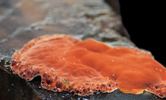Kingdom Fungi Class Basidiomycetes Genus Taiwanofungus | Division Basidiomycota Family incertae sedis Rank Species | |
 | ||
Similar Antrodia, Antrodia cinnamomea, Polyporaceae, Aphyllophorales, Ganoderma | ||
Taiwanofungus camphoratus, also known as stout camphor fungus (Chinese: 牛樟芝), is a species of fungus that is endemic to Taiwan, where it grows only on the endemic tree Cinnamomum kanehirae, causing a brown heart rot. Synonyms include Antrodia camphorata and Ganoderma camphoratum.
Contents
Traditional medicine
The fungus is well-known and highly valued as a medicinal mushroom in Taiwan where it is known as niu-chang, niu-chang-ku, or niu-chang-chih. It is commonly used as an anti-cancer, anti-itching, anti-allergy, anti-fatigue, and liver protective herb in Taiwanese traditional medicine. An extract was reported to slow the growth of human breast cancer cells. A water extract of mycelium grown in liquid culture has been reported to have antioxidant and anticancer properties in vitro.
Recently, the 32.15 Mb genome containing 9,254 genes was sequenced.
Chemical constituents
Antcin B, antrodioxolanone, antrocamphin B, antroquinonol, antrocamphins, zhankuic acids, and other antcins have been reported as constituents of Taiwanofungus camphoratus.
Ecological concern
Because of its use as a medicinal mushroom, fruiting bodies of the fungus can fetch high prices. Good quality fruiting bodies were reported to cost as much as US $15,000/kg in 1997, before artificial cultivation methods were developed. Some have illegally farmed the fungus in the forests of Taiwan by hollowing out endangered stout camphor trees (Cinnamomum kanehirae or niu zhang Chinese: 牛樟). This despite the equal potency of T. camphotatus grown indoors.
